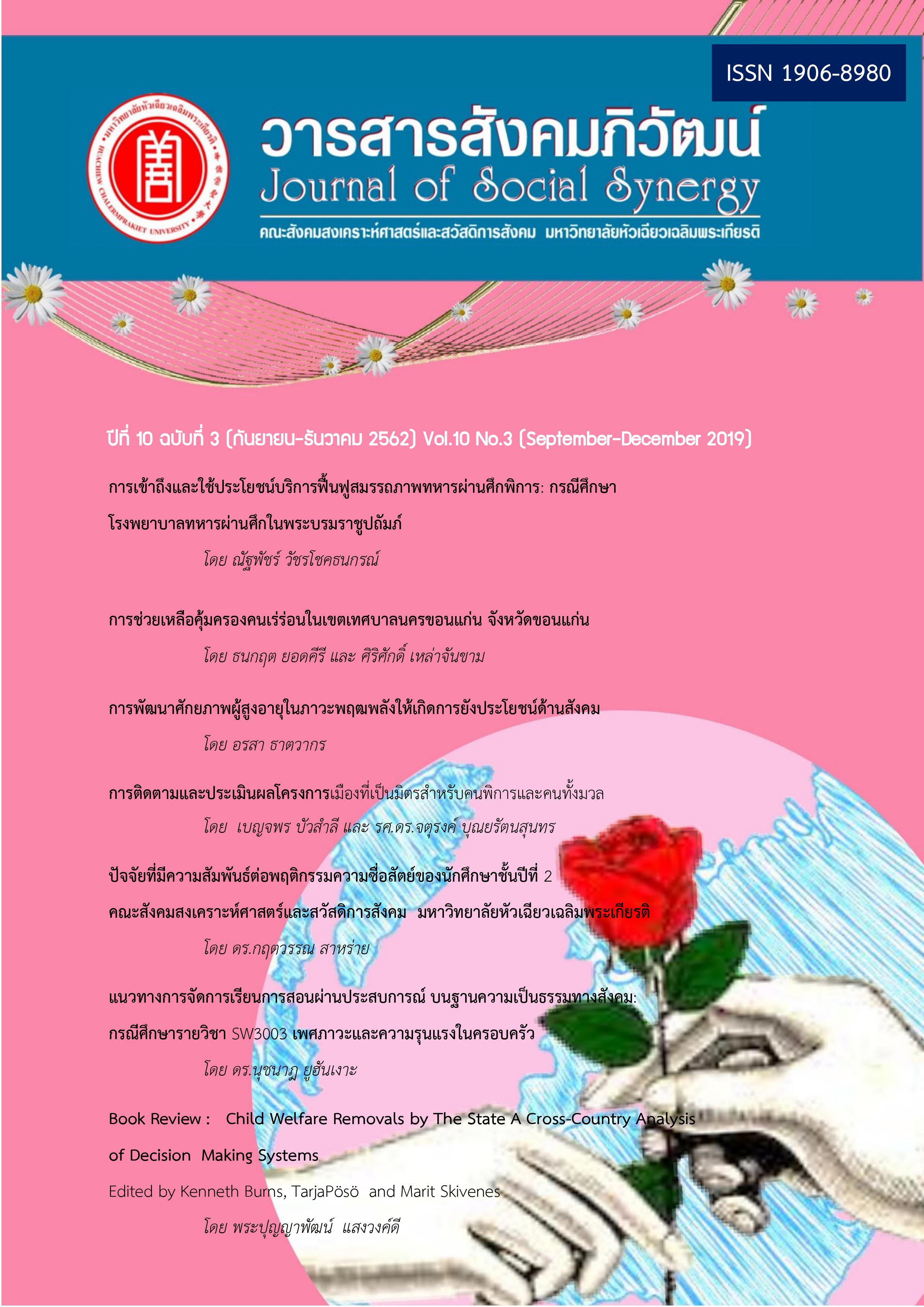Monitoring and Evaluation Smile City for All Project
Keywords:
Smile City for All Project, Monitoring and EvaluationAbstract
The purpose of monitoring and evaluation smile city for all project was three-fold: (1) to monitor and evaluate efficiency, effectiveness, output, outcome of Smile City for All Project under Empowerment of Persons with Disabilities Department in 2019 fiscal year, (2) to analyze data and feedback updated data to the people concerned, and (3) to suggest organization concerned to adjust and develop flagship project becoming more efficient.
Qualitative research methodology was employed by using in-depth interview the Director of Provincial Disability Services Center and officer who responsible smile city for all project, Chief Executive of Sub-district Administrative Organization (SAO) and staff in the areas where was selected as the pilot of smile city for all project including field visit the persons with disabilities' house.
The result of the study was Provincial Disability Services Center in 8 pilot provinces namely Chiang Mai, Phitsanulok, Nonthaburi, Chonburi, Khon Kaen, Udon Thani, Songkhla, and Krabi had been helped persons with disabilities to access medical service, education, occupation, employment, and social welfare services. Chief Executive of SAOs and staff provided good take care to PWDs by coordinating with Village Health Volunteer (VHV) to take care of persons with disabilities (PWDs) in the local area. However, the statistic of employment and loan approval for PWDs in some pilot provinces was decreased.
Researcher suggests the Department of Empowerment of Persons with Disabilities should fully support 8 pilot provinces to obviously smile city for all especially 5 facilities namely ramp for mobility disabled, car parking, lavatory, disabled person sign, and information center for PWDs. Database of all provinces should be developed to facilitate the storage, retrieval, modification, and deletion for developing the quality of life of PWDs. Innovation for independent living of PWDs at a sub-district level should be developed by coordinating with organizations both internal and external province. Persons with disabilities' organizations (PDOs) should be strengthened to help PWDOs pass standard criteria which would help PDOs to participate in creating quality of smile city for all in sub-districts and province levels.
References
กรมส่งเสริมและพัฒนาคุณภาพชีวิตคนพิการ. (2550, 18 กันยายน). พระราชบัญญัติส่งเสริมและพัฒนาคุณภาพชีวิตคนพิการ พ.ศ. 2550 และที่แก้ไขเพิ่มเติม (ฉบับที่ 2) พ.ศ. 2556. สืบค้น 20 สิงหาคม 2562, จาก http://dep.go.th/Content/View/4406/1
Cronbach, Lee J. (1973). Dictionary of education. New York: McGraw-Hill Book Co,.
Donald E. Chambers, Kenneth R. Wedel, and Mary K. Rodwell.. (1992). Evaluating Social Programs. Boston: Allyn and Bacon.
Dunn, W.N. (1981). Public Policy Analysis: An Introduction. Englewood Cliffs, NJ: Prentice- Hall, Inc.
Provus.M. (1971). Discrepancy Evaluation for Education Program Improvement and Assessment. Berkeley. CA. McCutchan.
Scriven, M. (1973). The Methodology of Evaluation AERA Monograph Series in Curriculum Evaluation. No.1 Chicago: Rand Menially.
Stake, Robert E. (2004). Standards-Based & Responsive Evaluation. Thousand Oaks: Sage Publications.
Stufflebeam, D.L. (2003). The CIPP model for evaluation. In D. L. Stufflebeam & T. Kellaghan (Eds.), The international handbook of educational evaluation (Chapter 2). Boston, MA: Kluwer Academic Publishers.
Taba, H. (1962). Curriculum Development Theory and Practice. New York: Harcourt, Brace.
Tyler, Ralph W. (1949). Basic Principles of Curriculum and Instruction. Chicago: The University of Chicago Press.
Downloads
Published
How to Cite
Issue
Section
License
บทความที่ได้รับการตีพิมพ์เป็นลิขสิทธิ์ของวารสารสังคมภิวัฒน์ มหาวิทยาลัยหัวเฉียวเฉลิมพระเกียรติ
ข้อความที่ปรากฏในบทความแต่ละเรื่องในวารสารวิชาการเล่มนี้เป็นความคิดเห็นส่วนตัวของผู้เขียนแต่ละท่านไม่เกี่ยวข้องกับมหาวิทยาลัยหัวเฉียวเฉลิมพระเกียรติ และคณาจารย์ท่านอื่นๆในมหาวิทยาลัยฯ แต่อย่างใด ความรับผิดชอบองค์ประกอบทั้งหมดของบทความแต่ละเรื่องเป็นของผู้เขียนแต่ละท่าน หากมีความผิดพลาดใดๆ ผู้เขียนแต่ละท่านจะรับผิดชอบบทความของตนเองแต่ผู้เดียว




